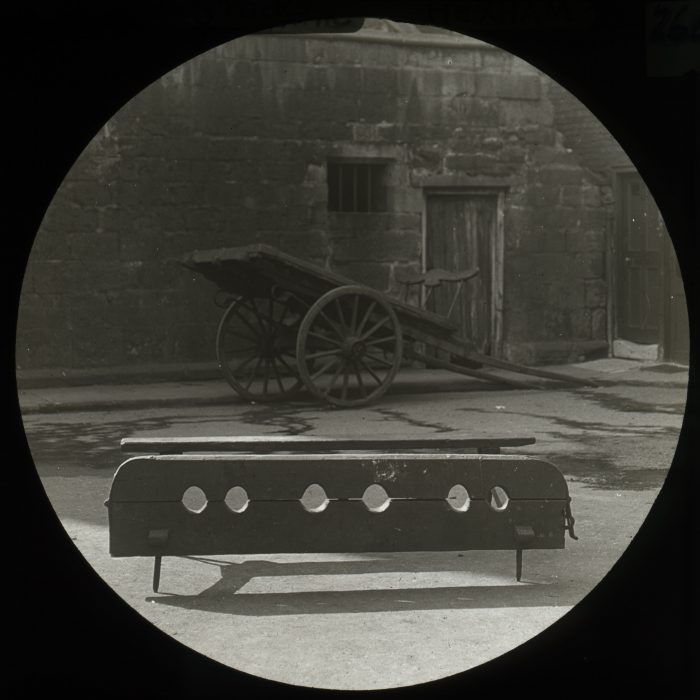Photographs of Stocks at Hexham, about 1900
Reference: SANT/PHO/SLI/8/268
Suggested age groups: KS1, KS2, KS3, KS4, lifelong learners
Subject areas: History, Maths, Literacy, Art and Design, Design Technology, Science
CONTEXT
“…for the securing of such idle and disorderly Persons, there ought to be a Pair of Stocks kept in good repair in each Tything…” Giles Jacob “The Compleat Courtkeeper”, 1724 p. 32.
A tithing was a group of ten householders that promised to abide by the law. If one of the people from the tithing committed a crime it was the duty of the rest to make sure that the lawbreaker was brought to justice. Although it is hard to say for certain whether each tithing kept and used a set of stocks, it does seem that most towns (like Hexham) did.
Stocks fastened the ankles of the “criminal”, who would have been sentenced to sit in the stocks for a certain amount of time. As well as being uncomfortable, this punishment involved the public shaming of someone who had committed a crime. Anyone watching might also throw things at the person being punished. The pillory was a similar punishment, but the criminal was fastened by their wrists and neck.
ACTIVITIES
ACTIVITY 1
Background
Methods of punishment in Tudor and Stuart times consisted of capital and corporal punishment carried out in public. If one of the people from the tithing committed a crime it was the duty of the rest to make sure that the lawbreaker was brought to justice. Although it is hard to say for certain whether each tithing kept and used a set of stocks, it does seem that most towns did.
SEE
See: What is a tithing?
See: Which body part was fastened to the stocks?
See: What is the difference between stocks and the pillory?
See: What did spectators do to the person being punished?
THINK
Think: What types of crimes might lead to someone being sentenced to sit in the stocks?
Think: How long could criminals be sentenced to spend in stocks?
Think: What types of crimes would lead to someone being sentenced to the pillory?
Think: Why was the rest of the tithing responsible for bringing the “criminal” to justice?
Think: Why was public shaming used as a form of punishment?
Think: Is public shaming used as a form of punishment today?
DO
Do: Research when the stocks were used in the UK for the first time and for the last time.
Do: Research the other methods of public punishment during this time period. Create a timeline showing when they were first and last used.
Do: Write a monologue as though you have been in the stocks to describe the experience. Consider how this might have felt physically and emotionally, what you did to be sentenced to the stocks, and what might have happened while you were there.
Resources
ACTIVITY 2
Background
Stocks fastened the ankles of the “criminal”, who would have been sentenced to sit in the stocks for a certain amount of time. As well as being uncomfortable, this punishment involved the public shaming of someone who had committed a crime. Anyone watching might also throw things at the person being punished. The pillory was a similar punishment, but the criminal was fastened by their wrists and neck.
SEE
See: What materials were stocks made from?
See: What size were stocks?
See: Where would stocks be placed?
See: How would a criminal be attached to the stocks?
See: What types of mechanisms would need to be included on stocks?
THINK
Think: The Statute of Labours Act of 1405 required all towns to have a set of stocks. Research when this law was abolished and how Thame Town Council in Oxfordshire suggested the stocks should be used in 2016.
Think: Discuss whether there is a place for stocks in the present day and come up with a pitch for how they could be used in Thame or your local town.
DO
Do: Imagine you are making a set of stocks. Make a list of the items that you would need to make it. How much of each item would you need and what would this cost?
Do: Imagine you are making a set of stocks. Make a drawing planning the design of the stocks. Label your materials and label the size and scale of the drawing.
Do: Create your set of stocks.
Note: People could create a set of stocks based around their pitch of how stocks could be used in present-day Thame or their local town.
Resources
OTHER ONLINE RESOURCES
Northumberland Archives blog website, page on “Private stocks and gallows – crime and punishment in the Manor (medieval)”:
https://northumberlandarchives.com/test/2017/01/24/privategallows/#more-3288
BBC Bitesize website, page about methods of punishment:
https://www.bbc.co.uk/bitesize/guides/z938v9q/revision/3#:~:text=Stocks%20and%20pillory,the%2016th%20and%2017th%20centuries.


